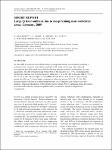Large Q fever outbreak due to sheep farming near residential areas, Germany, 2005
Gilsdorf, Andreas
Kroh, C.
Grimm, S.
Jensen, Evelin
Wagner-Wiening, Christiane
Alpers, Katharina
In June 2005 Coxiella burnetii-infected sheep, grazing and lambing on a meadow bordering a residential area, caused a large Q fever outbreak (331 cases) in Germany. Our outbreak investigation provided attack rates (AR) by distance between residence and meadow, sex and age groups. The AR of people living within 50 m of the meadow was 11·8%. It decreased the further the residence was from the meadow, falling to 1·3% at 350–400 m distance (RR 8·7, 95% CI 4·5–17·1). The AR was higher in men (RR 1·4, 95% CI 1·1–1·8). In the 25–64 years age group, the AR was 2·3 times higher compared to other age groups (95% CI 1·7–3·0). The distance-related AR showed a relationship between risk of infection and living close to the meadow. Ongoing urbanization will probably lead to further Q fever outbreaks, hence prevention activities undertaken by animal and public health practitioners should be aligned and strengthened.
No license information

